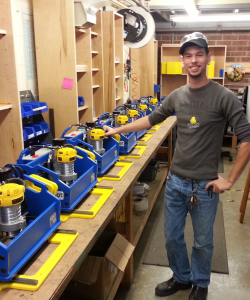 Nowadays, we can all appreciate the chorus for re-shoring American manufacturing and hope that it may bring some jobs back to our communities. Yet there is an irony that, despite the wide recognition of our declining manufacturing base, proposals for manufacturing start-ups only grab attention when they are so compelling, so promising, that they can quickly scale to mass-production in China.
Nowadays, we can all appreciate the chorus for re-shoring American manufacturing and hope that it may bring some jobs back to our communities. Yet there is an irony that, despite the wide recognition of our declining manufacturing base, proposals for manufacturing start-ups only grab attention when they are so compelling, so promising, that they can quickly scale to mass-production in China.
Current Heroes
The outsourcing of mass-production has become emblematic of success for our manufacturing entrepreneurs. Many of our institutions make heroes of those who scale to off-shored success. Venture capital PR, media hype, and government stimulus programs have helped spread a message that entrepreneurs should be valued for their visions of “high-impact products”, high-impact being little more than investor-speak for “high potential return”. We have created a counter-productive choice for our would-be manufacturing heroes that now hampers re-energizing local manufacturing.
New Opportunities
Affordable digital and robotic technologies for production are making small- and medium-scale manufacturing realistically competitive again. An enthusiastic case for a renewed manufacturing around these digital fabrication technologies has been called the “new industrial revolution” — by which small, digital-technology-based-businesses are seen as a possible core for a new manufacturing economy.
As an enabler of small operations, digital fabrication is more than a reprise of the hand-made, more than a sort-of super Etsy. Etsy does benefit from digital networks and logistics — the internet of wide-spread marketing and good shipping. But, the new-industrial-revolution concept takes networks and logistics only as a starting point, before more powerfully engaging digital design, digital product development and prototyping, digital control of machinery, digital collaboration, and digital data management to make small shops competitive again.
Less than half as many Americans are working in manufacturing today as in 1960. It is increasingly appreciated that this shift is due at least as much to technology and productivity efficiency as it is to offshoring. So it is unreasonable to expect that we’ll ever again have a large middle class supported exclusively by manufacturing jobs. More realistically, what we can hope for is some attractive new jobs in technology-based manufacturing — while we also re-embrace the importance of doing value-creating, innovation-spurring, production in our communities.
New technologies and our renewed engagement in DIY-making mean that there is an opportunity for re-invigorating manufacturing in our communities. Being productive does not need to be only about profit. Hands-on work that is rewarding, fulfilling, sustaining, and a source of value … that’s the spirit that we share with the makers and community blacksmiths of our history. Yet, the re-establishment of production in our communities is not inevitable. If we hope for it to re-emerge, we will need to be supportive of it. We will need to cultivate new manufacturing heroes.
This is an abbreviated version of the first in a series of articles on our manufacturing future and new fabrication technologies. Please see Full Article.